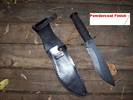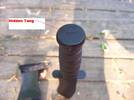There are a few things to watch for when purchasing a knife especially if you will be betting your survival on it. A lot of knives may be expensive but not necessarily good quality. They are hoping you will be uneducated and purchase on appearance alone. A high majority of knives are made from either 440 which is the Americans most common knife steel. It is okay, you can buy a knife with that steel from $15.00- $100.00. There is a huge price difference but the same steel. The AUS series steel is Asia’s version of the same type of steel. Both type of steel hold an edge ok, but not great. There is also a 600 series steel which is softer steel. It sharpens quickly but also gets dull quickly.
Knife steel can be made with numerous components. There is carbon which gives you your strength and edge holding ability. Most knives are considered stainless steel. This means they add chromium to the steel to make it rust resistant. The problem with this is the more chromium you add the less carbon they can add. So you loose edge holding ability to gain rust resistance. The old knife that your grandfather loved probably had a blade that had turned black, not shiny. This is called oxidization. It is a natural occurrence is high quality, non-stainless steels. The oxidization actually creates a rust resistant barrier, it is not rust proof but will resist rust. Any knife stainless or non-stainless needs to be taken care of if you want to last. Keep it clean and oil the blade occasionally. If you use it for cutting meat or other foods then use a cooking oil.
I prefer a knife made from tool steel. My favorite is 1095 tool steel. Most of these knives have a powder coated finish (blade painted black), to prevent it from rusting. It contains no chromium so the steel holds an edge incredibly well. The other reason I like this steel is that it can be used to start a fire. If you take a rock and strike it along the back of the blade it will create a spark, but that’s a whole other subject.
After a blade is made the steel is tempered which means the steel is hardened. This is done by heating the blade until it is no longer magnetic. The blade is then quenched in a liquid. Different liquids cool the steel at different rates. Water cools the steel quickly, this will make it very hard but also brittle. It could shatter like glass. Quenching in oil, cools the steel slower to make it less likely to break. After the knife has been tempered the stress in the steel is released by heating it up again to about 350 deg and then air cooling. Now why would anyone care about this process? The reason I am explaining this to you is that every knife can be hardened to different hardness’s. The hardness is measured and graded by the Rockwell hardness scale. I prefer a knife with a Rockwell hardness of 56-58. This means it is hard enough to hold an edge for a long time but yet it is not to hard to re-sharpen easily.
The other thing I look for in a knife is how it is made. If you are only taking one knife, it must not be a folding knife. A folding knife has a joint that could fail and break. Get a one piece knife. Not all non-folding knives are build the same either. A knife must have a full tang. This means that the blade steel runs the full length of the handle. This makes the handle/ blade joint very strong. There are two basic types of full tang knives. You can have a hidden tang, or an exposed tang. A hidden tang means the tang is not visible until the end of the handle. The exposed tang has two pieces of handle material, one riveted to each side of the tang. Both of these are great choices.
 - Survival Knife
 - Survival Knife
|







